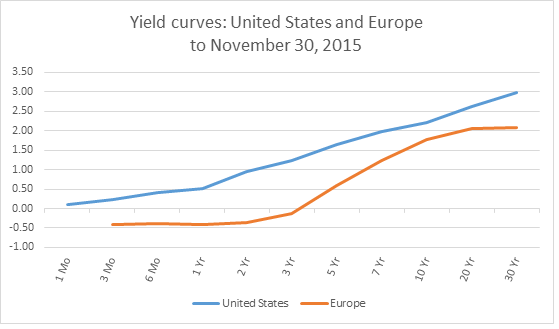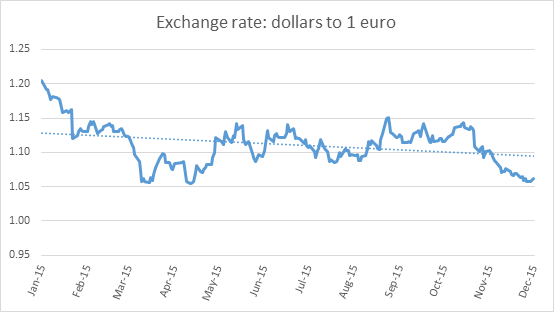Negative Interest Rates and Exchange Rates: The United States and Europe, What Does the Future Hold?

By Clynton R. López F. December, 7 2015
Translated from Spanish by Katarina Hall
Negative interest rates are an unusual phenomenon in the real economy. In order to understand them, we need to look at the objectives of monetary policy. When monetary authorities want to change the behavior of individuals, through substitution effects, they create policies that imply incurred costs for people who continue their usual behavior. For example, if the monetary authority considers the loan growth too slow to reach the economic growth target laid out by economic policies, it may reduce the discount rates of the central bank’s loan funds for other banks, reduce bank reserves, or enforce negative interest rates on funds deposited at the central bank in excess of the reserve requirement. This is how a cost for cash balances is enforced on financial institutions, incentivizing them—theoretically, at least—to place such funds in the real economy.
In graph 1, we see the typical yield curve for different terms through November in the United States and Europe. The two curves show the returns on bonds from European countries and US treasury bonds at different terms. Although the bonds also reflect country risk and economic zones, they primarily indicate the implementation status of a given country’s monetary policy.
The graph indicates that the eurozone has negative interest rates until the five-year mark. In the short term, the US interest rate is close to zero, however, it maintains positive nominal values. What are the unforeseen or unwelcome effects of these policies?
The effects normally expected from these kinds of policies—the United States and Europe are no exception—include a reduction of the so-called liquidity preference and an increase in credit demand in order to obtain returns through the real economy. Theoretically, this should induce greater economic growth, reduce unemployment, and possibly provide a positive value for inflation.
What effects did we see? Staying true to its historical volatility, the United States saw unstable economic growth at just 2.1% in the third quarter of 2015, while the eurozone maintained 1.6%—both preliminary data. The unemployment rate for the United States is 5%, and in Europe 10% (data through October 2015). The inflation rate for the United States is 0.2% and 0.1% in the Eurozone (data through September 2015). Credit growth data in Europe did not show any major changes until June, and in the United States it was not until October that the traditional commercial bank showed relevant growth in consumer credits, real estate, and interbank credits.
What unintended consequences can we expect? Some of the unintended consequences can already be seen in both economic regions. Throughout 2015, the euro depreciated against the dollar (as seen in graph 2). The Federal Reserve, pursuing growth and unemployment objectives, will likely end the current federal funds policy close to zero at its next meeting. If the Federal Reserve increases the federal funds rate, following unemployment data and changes in last-minute credit, it would exacerbate the difference with the eurozone’s negative interest rates, and possibly, depreciate the euro against the dollar. It appears that the European Central Bank’s quantitative easing program was not successful and the policy implemented by the Federal Reserve had better results. The underlying question is, has economic growth in these regions, especially the United States, undergone a significant distortion in relative prices and investment? Time will tell if these policies saved the world from financial collapse in 2008 or triggered another crisis by generating distortions or a gradual impoverishment of these regions through decreased volatility.
Further details about these two economic zones can be found in the next quarterly report from UFM Market Trends.
Get our free exclusive report on our unique methodology to predict recessions

Clynton López
Clynton López is a professor at the Francisco Marroquín University since 2002 in the areas of economics and philosophy. He has a degree in Economics with a specialization in Finance from the Francisco Marroquín University and a master in Economics from the same university, both Magna Cum Laude. He studied executive programs at Boston University on Managerial Economics & Corporate Finance, the Master of Philosophy at the Rafael Landívar University (specialization in phenomenology), and the Post Graduate Degree in INCAE for Senior Management. In the professional field he has more than 10 years of management experience in banking and financial companies in Guatemala, California and Puerto Rico, and is a member of the Mont Pelerin Society.
Get our free exclusive report on our unique methodology to predict recessions




